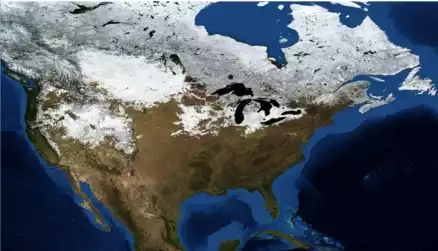Module: Climate Change and Snow Cover Patterns
Summary
This learning module integrates NASA resources with the Intergovernmental Panel on Climate Change (IPCC) Report, National Climate Data Center (NCDC), and basic statistical analysis to create an exercise that evaluates spatial patterns of the Spring freezing line during past climates and the likely shifting of this line in the wake of anticipated temperature increases in the future.
Funded by NASA Global Climate Change Education Grant NNXO9AL64G.
Learning Goals
1. To introduce students to additional climate variables including Spring freezing line and snow cover and how these impact water resources and other human-related causes.
2. To reinforce basic statistical analysis techniques using climate data.
3. To introduce students to basic climate modeling using simple linear regression.
4. To introduces students to the IPCC Report.
Context for Use
1. Students should have a basic understanding of climate and climate change.
2. Students should have basic computer and statistical knowledge.
3. The exercise will run more smoothly if an overview of Excel and regression is presented prior to the exercise.
4. This lab would be best suited as an exercise to reinforce a lecture discussion on climate change and possible future changes expected as summarized in the IPCC report.
5. Including introductory notes and a possible example involving Excel functions, approximately 2 hours is needed to complete the exercise.
6. Students might benefit if permitted to work in pairs, especially given the background knowledge of computer and statistics that is needed.
Description and Teaching Materials
2. Computer equipped with Microsoft Excel and PowerPoint (v. 2007 or newer)
3. Colored pencils.
Satellite Images of US Snow Cover
MODIS_seasons_NOLABEL.pptx
Climate Data
Climate_Data_BLANK.xlsx
Map of Climate Gradient
Climate_Gradient_Map.jpg
Blank US Map
blank_us_map.pdf
Climate Change and Snow Cover Asssignment
Snow_Cover_Assignment.pdf
Teaching Notes and Tips
1. Create an example to introduce students to the concept of modeling and linear regression in Excel.
2. Quickly review Excel functions needed for this exercise.
3. Areas of concern for students will likely include setting up the regression analysis and graphing in Excel.
4. Users might have to allow access to websites when viewing assignment in PDF version depending on security settings.
Assessment
1. Students can create a data set used for modeling future climate and predict the location of the Spring freezing line.
2. Students correctly associate snow cover and its influence on human-related causes and understand the ramifications of a shifting freezing line.
References and Resources
Links provided in Assignment.
Citation
Spigel, K. (2012). Module: Climate Change and Snow Cover Patterns.


![[creative commons]](/images/creativecommons_16.png)